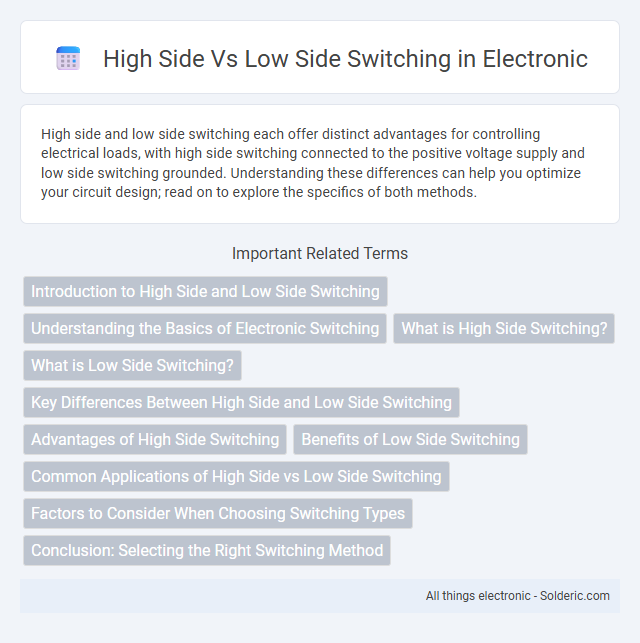High side and low side switching each offer distinct advantages for controlling electrical loads, with high side switching connected to the positive voltage supply and low side switching grounded. Understanding these differences can help you optimize your circuit design; read on to explore the specifics of both methods.
Comparison Table
| Feature | High Side Switching | Low Side Switching |
|---|---|---|
| Switch Position | Between power supply and load | Between load and ground |
| Load Reference | Connected to ground | Connected to power supply |
| Control Signal Voltage | Close to supply voltage | Close to ground potential |
| Common Applications | Powering positive voltage loads, automotive systems | Switching low-side loads, DC motors, LEDs |
| Safety | Higher safety, load not grounded when off | Lower safety, load grounded when off |
| Complexity | More complex driver circuitry | Simple and cost-effective implementation |
| Switch Types | P-Channel MOSFET, PNP transistor | N-Channel MOSFET, NPN transistor |
Introduction to High Side and Low Side Switching
High side switching involves placing the switch between the power supply and the load, controlling the positive voltage line, which offers safer load isolation and easier integration with common ground systems. Low side switching locates the switch between the load and ground, simplifying circuit design and reducing component costs but can cause grounding issues and limit control options. Both methods are essential in electronic circuit design, with high side switches preferred for load safety and low side switches favored for cost-effective applications.
Understanding the Basics of Electronic Switching
High side switching controls the power supply line, connecting the load to the positive voltage, which ensures better safety and simplifies grounding, while low side switching controls the ground line, connecting the load to ground, often making circuit design more straightforward but potentially less safe. Understanding these basic concepts helps you choose the appropriate switching method for your electronic circuits based on factors like load type, safety requirements, and control logic. Proper selection between high side and low side switching is essential for optimizing performance and reliability in electronic systems.
What is High Side Switching?
High side switching controls the power supply line by connecting the load to the positive voltage source, enabling current flow when the switch is closed. This method offers protection against short circuits and is preferred in systems requiring load isolation from ground. Understanding high side switching helps you optimize circuit design for enhanced safety and reliability.
What is Low Side Switching?
Low side switching refers to controlling an electrical load by connecting the switch between the load and the ground (negative) side of the power supply. This method allows the load to be connected directly to the positive voltage, while the switch completes the circuit by grounding the load when activated. Low side switches are commonly used in automotive and industrial applications for their simple wiring and cost-effectiveness.
Key Differences Between High Side and Low Side Switching
High side switching controls the load by connecting it to the positive voltage supply, while low side switching connects the load to ground, influencing their application based on voltage levels and safety. High side switching offers better protection against short circuits and is preferred in automotive and industrial systems for switching positive voltage. Low side switching is simpler, cost-effective, and commonly used for switching devices grounded to the common negative, making it ideal for many basic electronic circuits.
Advantages of High Side Switching
High side switching offers enhanced safety by connecting the load directly to the supply voltage, reducing the risk of short circuits to ground and improving system protection. It provides better noise immunity and more accurate control in automotive and industrial applications by controlling the positive voltage line, which is often the reference point in these systems. High side switches also facilitate easier monitoring and diagnostics of loads, ensuring more reliable and efficient power management.
Benefits of Low Side Switching
Low side switching offers simplified circuit design and easier implementation due to its grounding on the load side, reducing wiring complexity and costs. Your system benefits from improved safety since the load is connected to the positive voltage, limiting potential high voltage exposure during maintenance. This method also allows for straightforward testing and troubleshooting, making low side switching a preferred choice in many automotive and industrial applications.
Common Applications of High Side vs Low Side Switching
High side switching is commonly used in automotive and industrial applications where controlling the positive voltage supply is critical for safety and efficiency, such as in powering motors and LED arrays. Low side switching is often preferred in digital circuits and LED drivers, providing simpler ground connection control for devices like relays and transistor switches. Both switching methods optimize circuit design depending on load type, voltage polarity, and protection requirements.
Factors to Consider When Choosing Switching Types
When choosing between high side and low side switching, factors such as load type, voltage requirements, and system safety must be carefully evaluated. High side switching is preferred for controlling positive voltage to the load, enhancing user safety by isolating the load from ground, while low side switching is simpler and cost-effective for switching the ground path. Your decision should also consider the complexity of circuitry, switching speed, and potential electromagnetic interference to ensure optimal performance.
Conclusion: Selecting the Right Switching Method
Choosing between high side and low side switching depends on the specific application requirements, such as load type, voltage levels, and safety considerations. High side switching offers better protection and is ideal for controlling the positive supply side, while low side switching is simpler and often used for switching ground connections in low-voltage circuits. Evaluating factors like efficiency, control complexity, and system design ensures optimal performance and reliability in electronic switching applications.
High Side vs Low Side Switching Infographic

 solderic.com
solderic.com